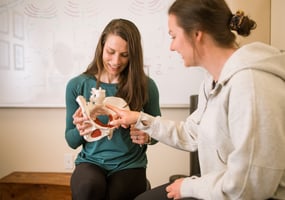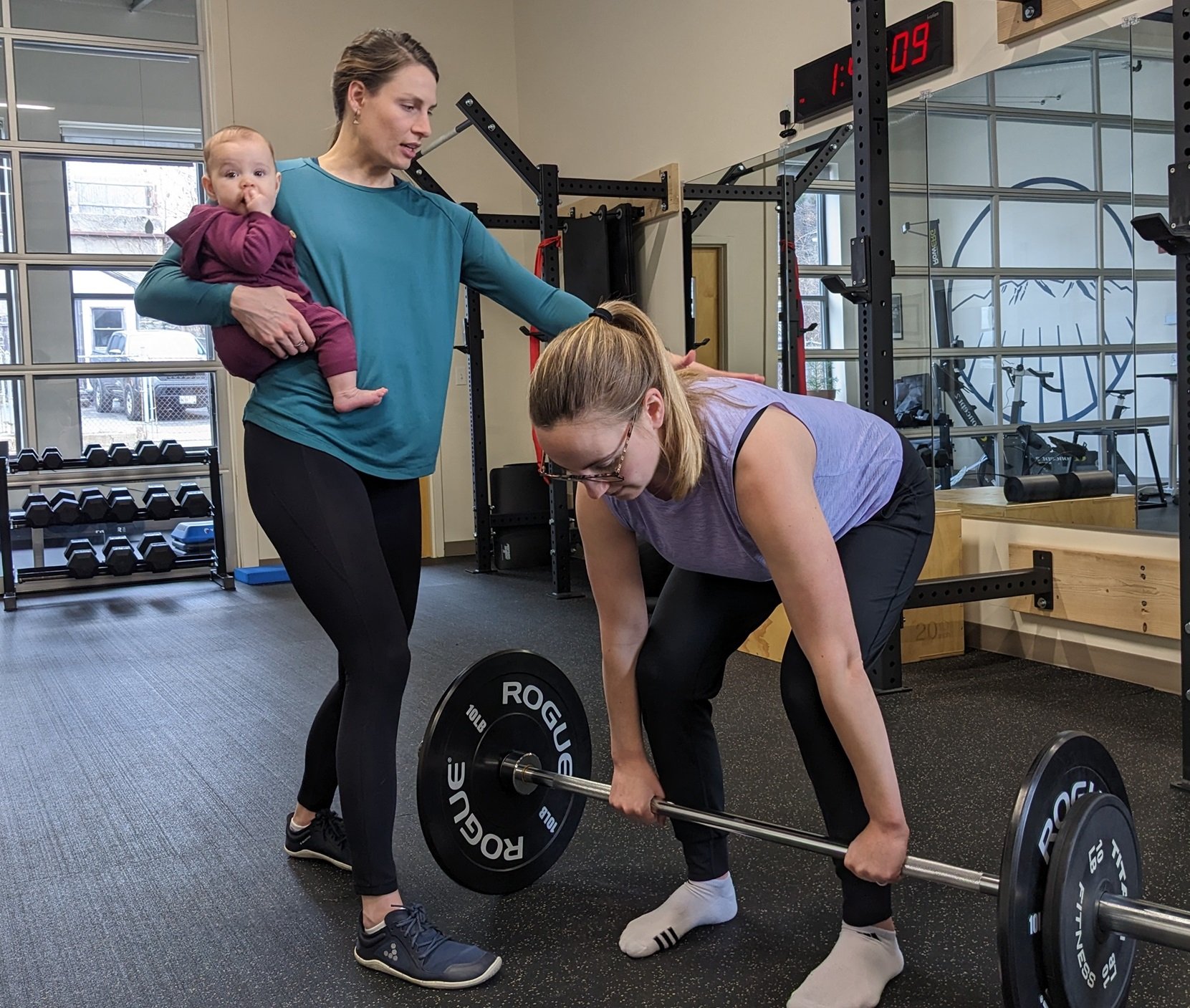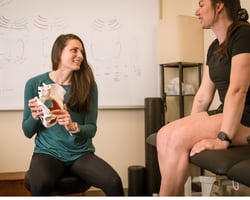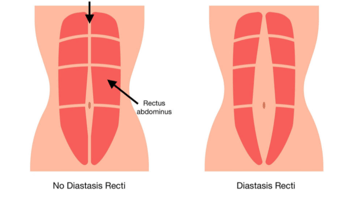
Pelvic Floor Physical Therapy for Runners & Active Adults in Portland, Maine
Blending Running, Orthopedic & Pelvic Floor Physical Therapy

Runners & Active Adults
If you're a runner or enjoy lifting, at any age, pelvic symptoms getting in the way of your activity are the worst. Our Pelvic Therapists specialize in helping you return to higher level activities without leaking or pelvic pain.

Pregnancy
Continuing to exercise during pregnancy can be tough when you're battling new symptoms every week. Fortunately the bony, joint, or muscle symptoms can be managed with the right treatment plan, allowing you to exercise as much of your pregnancy as you'd like.

Postpartum Rehab
Postpartum is not just 6 weeks or 1 year - it's forever! Our Pelvic Floor Therapists are experts at helping moms return to running, lifting, and jumping - symptom-free. To return to these activities, proper rehab must eventually include much higher level exercises than simple birddogs and bridges!
Pelvic Floor Dysfunction Isn’t Just a Postpartum Problem
Pelvic floor issues affect runners, lifters, and active people of all ages—whether or not you’ve had kids. And while these symptoms are common, they’re not something you have to live with.
If you’re dealing with leaking during runs, pelvic or low back pain with impact, or a feeling of heaviness or pressure, it’s time to work with someone who understands both pelvic health and performance. At Steady State, we help runners and active adults across Southern Maine address pelvic floor dysfunction with an approach that blends orthopedic rehab, strength training, and evidence-based pelvic care.
Signs You May Benefit from Pelvic Floor PT
- Leaking with running, lifting, jumping, or sneezing
- Pressure or heaviness in the pelvic region
- Pain in the hips, groin, SI joint, or low back—especially during activity
- Increased core fatigue or poor control with impact
- A history of injury or dysfunction that hasn’t improved with traditional PT
Why Choose Steady State for Pelvic PT?
Unlike traditional pelvic PT clinics, our team doesn’t just focus on symptoms—we treat the whole person with a performance-minded approach. That means:
- You’ll work with a pelvic floor physical therapist who’s also a runner and strength athlete
- We integrate pelvic health work with orthopedic assessment, movement screening, and training load guidance
- You’ll build strength and resilience in a way that reflects your real-world activities
You won’t be told to stop doing what you love. We meet you where you’re at and help you return with confidence.
Our Approach to Pelvic PT for Runners & Active People
-
Thorough Assessment
We’ll look at pelvic floor function, breathing mechanics, posture, mobility, and how your body moves during activity. This isn’t just an internal exam—it’s a full-body evaluation to find the true source of dysfunction. -
Movement-Based Rehab
We integrate pelvic floor strategies into strength work, breath control, and return-to-impact exercises so your rehab reflects your goals—not just basic Kegels. -
Running & Lifting Readiness
We’ll help you return to your sport safely, using run progression, strength benchmarks, and gait or movement analysis if needed. -
Education & Empowerment
You’ll leave each session knowing what you’re working on, why it matters, and how to adjust based on symptoms and training load.
For a deeper look at how pelvic floor therapy supports runners, read our blog: Understanding Pelvic Floor Therapy: Beyond Kegels and Postpartum
Common Conditions We Help With
- Stress or urge urinary incontinence
- Pelvic organ prolapse symptoms
- Pelvic or low back pain with running or lifting
- Post-surgical pelvic dysfunction
- Coordination issues between core, pelvic floor, and breath
Learn more on our Pelvic Conditions We Treat page.
Related Pelvic Services
Looking for care specific to your season of life? Explore our other offerings:
- Pelvic PT During Pregnancy: The Birth Prep Program
- Postpartum Return to Run Program
- Your First Pelvic PT Visit at Steady State – What to expect and how we guide you from day one
Serving Runners & Active Adults Across Southern Maine
From training to run the Beach to Beacon to strength training at your local gym, we help active individuals across Portland, Scarborough, Falmouth, and beyond resolve their pelvic symptoms to get strong, active, and feel empowered.
Ready to Feel Strong from the Inside Out?
You don’t have to push through discomfort, leaking, or fear of movement. We’ll help you get to the root of the issue and build lasting strength where it matters most.
📅 Schedule Your Free Discovery Call with One of our Pelvic PTs Today to See If Pelvic PT is Right for You.
Schedule a Free 15-20 Minute Discovery Call with a Pelvic PT
We want to first make sure that we're a good fit for you!
Pelvic Health Testimonials
“Steady State has quite literally changed my life. For over 5 years I was struggling with pelvic floor dysfunction and never found the right way to manage it- until physical therapy with Steady State. I tried everything there was in those 5 years, even went to a different PT. But Steady State goes above and beyond.
If you are also struggling with pelvic floor dysfunction, you need to go to Steady State. Almost 1 year working with them and I am the strongest I have ever been, I am more comfortable and confident in my body, and I no longer let PFD take over. I cannot recommend this place enough! Oh- and the entire staff are some of the nicest people you will ever meet.”
"I saw Ashten early on in my pregnancy with a goal to remain physically active and fit but do so in a safe way. She gave me a great prenatal workout plan specific to my goals and needs, and in doing so my fears of "working out the wrong way" washed away. She helped me recognize my areas of strengths and weaknesses as well.
Halfway through my second trimester I started to suffer from severe pain in my left hip and had a terrible limp- Ashten was quick to help me and diagnosed me with pelvic girdle pain (something that can occur during pregnancy). She listened to all of my concerns and gave me exercises to help strengthen my core and lower back which were undergoing many changes due to pregnancy. She even taught me how to properly get in and out of bed and move smarter while accomplishing daily tasks.
After a couple of weeks of consistently doing the exercises Ashten gave me, my hip pain went from an 8 to nearly a 2!! And now, at 32 weeks pregnant I can honestly say I feel the best I have so far and am still very active! Ashten is more than a physical therapist, she is a true, devoted friend who wants the absolute best for everyone and won't stop until you get there! Thank you, Ashten!"
"I started seeing Ashten almost 1.5 years ago initially for pelvic floor PT. She was amazing and I noticed differences within a few months.
As we progressed, my running was able to progress and she helped me with strength training, marathon training, and I was able to run a marathon this spring and qualify for Boston. She helped my legs get stronger to prevent old injuries from flaring that has halted marathon training every time I’ve tried to start. I recommend Steady State to anyone!"
Ready to Get Your Life Back & Live Symptom-Free?
Learn more with a Free 20-Minute Discovery Call today!
-
24 Romasco Ln, Portland Maine 04101
-
admin@steadystatehealth.com
-
+1 207-200-9409








